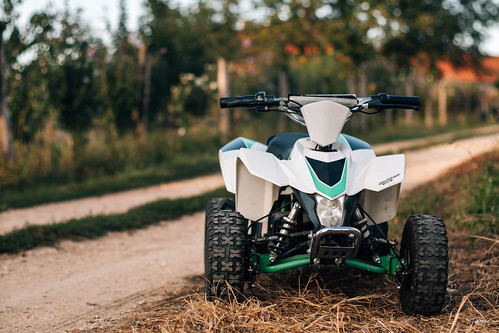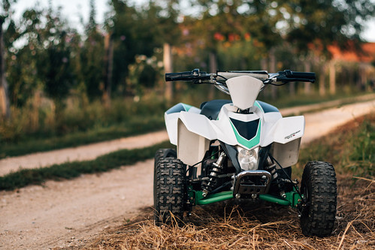A Complete Guide to ATV or UTV
Posted by Wet Sounds on 7th Dec 2021
After listening to your friends' stories about all the fun they have off-road trail riding on the weekends, you've decided it's time to get yourself an off-road machine to join them. The first question you'll need to ask yourself is whether you want an ATV or a UTV. What's the difference between the two? Why would you consider one over the other? In order to make an informed decision, it's important to know the difference between an ATV and a UTV before heading out to purchase one.
What Is an ATV?

Image via Flickr by Ivan Radic
ATV stands for all-terrain vehicle, which is a motorized vehicle designed for off-road use. It has four non-pneumatic or low-pressure tires and is designed to be straddled by the driver with handlebars for steering and controls. There are two types of ATVs as designated by the manufacturers: Type I for a single rider and Type II for a single rider or additional passenger. The main difference would be that a Type II ATV has a designated spot for a passenger to sit behind the driver. ATVs also come in a variety of sizes ranging from youth to adult.
ATVs are rated by engine size, with an engine over 90cc considered an adult-sized machine. You can also get ATVs as sport and utility vehicles, with youth-sized options that operate at slower speeds and are designed for smaller bodies. ATV size and age recommendations are:
- Under 70cc for ages 6-11.
- 70-90cc for ages 12-15.
- Over 90cc for 16 and older.
Previously, there was a three-wheel ATV option, but due to safety concerns, the manufacturers have banned their production for years, leaving only the four-wheel options today. If you're looking at used ATVs, do not purchase a three-wheel ATV as they are less stable and more prone to rollovers, creating a variety of safety issues.
What Is a UTV?
UTV stands for utility terrain vehicle or utility task vehicle, depending on who you ask. They've also been called side-by-sides and ROV or recreational off-highway vehicles. UTVs are another off-road vehicle designed for a driver and up to five passengers, depending on the size of the UTV. A steering wheel usually operates UTVs instead of handlebars like an ATV, and they have brake and gas pedals much like a car. UTVs also often come equipped with a cage or roll bar to protect the passengers further. You will also find seatbelts in many UTV models.
There are several different models of UTV to choose from, such as sport, sport-utility, utility, trail legal (50-inch), commercial, mid-size, full-size, multi-passenger, and Lightweight Tactical All-Terrain Vehicles used exclusively by the military. The engine size of UTVs varies from 500-1000cc, with a cap of 1000cc to be considered a UTV. Anything over 1000cc is regarded as a car, which then adds a lot of safety requirements and stricter emissions testing.
What's the Difference Between an ATV and a UTV?
Other than the fundamental constructional differences between the two, there are some other factors to consider that set them apart:
Passengers
The most significant difference is in passenger space. With an ATV, you can bring along one friend for the ride if you own a Type II. Adding a rear lounger will make their ride more comfortable, but they still spend the ride straddling the driver.
A UTV allows the driver to bring up to five friends out on the trail, depending on the model. All UTVs have room for at least one passenger, and any passengers sit in their own seats, often with seatbelts and even cupholders.
Purpose
If you're a speed demon, you may want to consider an ATV for your off-road purchase. They are generally lighter and smaller to allow for sharper turns and fit in tighter spaces and make them faster, perfect for racing. Solo riders can experience quite an adrenaline rush speeding over the trails on an ATV. The smaller size also appeals to riders who want to use their ATV for hunting in the deep woods as it's easier to maneuver the machine amongst the trees.
On the other hand, UTVs are great for getting some work done because they offer more cargo space and are built for labor-intensive activities such as hauling. The average cargo load for ATVs is 125 to 400 pounds, where a UTV can carry from 800 to 1,350 pounds. UTVs also provide a higher towing capacity, making them more work-ready. Farmers tend to lean towards UTVs because they offer features similar to a sub-compact tractor. You can even add scrapers, loaders, mowers, and plows to your UTV, depending on the model.
Cost
The average ATV will cost less than the average UTV when it comes to the base price. You can also end up spending a lot of money adding upgrades, accessories, customizations, and tools to a UTV. ATVs don't have as many options for customization, so once you've purchased the vehicle, the major expense is done. When considering the purchase price of an ATV or UTV, remember to include the safety gear and accessories you will need to operate your machine. These expenses include helmets, gloves, goggles, loading ramps, and any protective clothing you'd like to add.
Driver Experience
Operating an ATV is more labor-intensive for the driver as you spend the entire ride straddling the machine and operating it via controls on the handlebars. You also have to maintain your balance regardless of what the terrain throws at you. The throttle of an ATV is typically at the thumbs, so a significant amount of hand strength is also required. Inexperienced drivers may find operating an ATV more difficult, taking away some of the ride's fun.
UTVs resemble cars, so if you can drive a car, you can operate a UTV. The driver and passengers all relax in bucket or bench seating while traveling across the terrain. Even the most inexperienced drivers will find that they can slide behind the wheel of a UTV, and with very little instruction, take off down the road quickly and easily.
Ultimately, the off-road experience you're looking for will help determine which vehicle is best for you. You will want to consider your budget and purpose as well as take into account your overall off-roading experience and whether or not you wish to take passengers along for the ride. Both ATVs and UTVs open up a whole new world of adventure, so enjoy!

